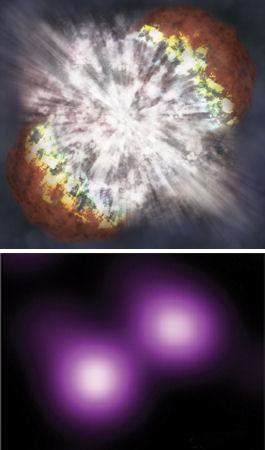Astronomers this week described the brightest stellar explosion ever recorded. In just 2 months, the eruption—the catastrophic death of what was probably a freakishly massive star—has thrown out as much radiation as the sun will during its entire 10-billion-year lifetime. One hundred times as energetic as a typical supernova, the outburst may belong to a rare, new class of explosions that’s been predicted by theory but never before observed.

According to that theory, the star that exploded must have been the heaviest on record, tipping the scale at more than 150 times the mass of the sun, says astronomer Nathan Smith of the University of California, Berkeley.
Smith’s team announced the findings on May 7 at a NASA press briefing and also reports its observations in an upcoming Astrophysical Journal. Another group of astronomers, led by Eran Ofek of the California Institute of Technology in Pasadena, describes the same supernova, now dubbed SN 2006gy, in the April 10 Astrophysical Journal Letters. The blast was discovered last September.
In a galaxy 240 million light-years from Earth, SN 2006gy remained brighter than any previously observed supernova for 3 months. Its “absolutely stupendous” brightness forced astronomers to consider alternatives to the usual scenarios for exploding stars, says Smith.
One standard type of supernova explosion occurs when a star at least 10 times as heavy as the sun exhausts its fuel supply. The star’s core abruptly crunches to become a neutron star or black hole, while the outer layers blow outward. But this core-collapse model can’t come close to explaining the brightness of SN 2006gy.
The teams led by Smith and Ofek propose that SN 2006gy marks the death of a star that was between 150 and 240 times as heavy as the sun. In such a star, energetic gamma rays push out from the core and resist gravity’s pull. Instability sets in when gamma rays annihilate each other and become pairs of electrons and positrons. As the rays vanish, the entire star collapses and then blows up, leaving behind no black hole or neutron star. This type of explosion, known as a pair-instability supernova, can produce an outburst as bright as SN 2006gy, the two teams suggest.
One problem with the model, says Smith, is that massive stars that are rich in heavy elements have fierce winds, which expel much of their material during their normal lifetimes. Too much lost mass could prevent such a star from exploding as a pair-instability supernova.
Star-formation theory suggests that the first stars in the universe were extremely massive but lacked heavy elements. Pair-instability supernovas might therefore have been common then. The star that exploded as 2006gy may be a rare, modern example, says Smith. In our own galaxy, the heavyweight star Eta Carinae (SN: 9/23/06, p. 200: Temperamental Monsters) could be ready to undergo a similar explosion, he notes.
Theorist Stan Woosley of the University of California, Santa Cruz prefers a less extreme version of the pair-instability model to explain SN 2006gy. He suggests that instead of only one explosion, repeated instabilities in the star hurled material outward for about a year before the final outburst. All the energy of that final blast would then go into heating the expelled material, rather than into pushing out material. The result would be a superbright explosion from a moderately massive star.







